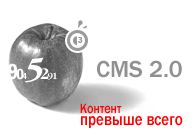Trends in the development of content management solutions or CMS 2.0

There are many opinions and often diametrically opposite about the prospects of Web 2.0, however, hardly anyone will argue with the fact that this concept has noticeably affected the modern Internet. In this regard, we developers it makes sense to follow the new trends, new trends of the market. Web 2.0 dictates its new requirements. In general, I will discuss the requirements for web development in the era of Web Next Generation in two weeks on PHPConf ( www.phpconf.ru ), but we will talk about new requirements for developing content management systems now.
The audience of CMS-based solutions can now be divided into three components: corporate users, Internet audience and third-party applications. As for the first two parts, these are people and time has determined our following preferences:
Working with web content, we strive to get rid of impersonal dialogues. We prefer materials of authors with due reputation, authors whom we trust. This is relevant not only for the Internet audience, but also in many applications of intranet systems. Modern solutions for content management should be able to maintain the profiles of authors, provide information about the author of the material, navigate through other materials of the author (by activity history), and rank the authors.
Nowadays, ownership of the content is more relevant than ownership of the software. Content other than the site can be delivered by third-party resources via widgets, web services, RSS, or desktop applications. Do not let your imagination limit the value of the content. Thus, the primary content, the second application for its delivery. In this regard, the CMS should allow content delivery in the requested format : HTML, WML, ATOM / RSS, JSON / XML, PDF, WSDL or, if you prefer, SVG.
')
Provide the possibility of using the whole variety of media formats in content management. You can use your own solutions for delivering content of these formats or popular flash players - Youtube.com for video podcasts, Slideshare.net for presentations, Scribd.com for MS-Word documents, etc.
However, it should be understood that the content available for Mashup , adaptation and layout can not be regarded as pages of the site. Content is informational entities presented on the pages of sites. Entities that can be systematized in RDF or through microformats . The meaning of the semantics of information entities within the CMS is obvious. At the program level, a structure based on a bidirectional graph or a repository formed on the basis of xLink declarations can be applied here. However, visualization of data structures in a GUI should be easily perceived by the user.
Participation architecture is a key trend of Web 2.0. The community places value on content and services. Your system now relies on being a content management platform in community-oriented applications. Let corporate users vote for content and this will allow management to better understand the needs and preferences of the company's team. Integrate into the Wiki platform and blogging systems, provide a unified user rights policy across all intranet applications.
The modern CMS user interface should be “rich” , but easy to use. With the current abundance of AJAX frameworks, it is not particularly difficult to “enrich” the user interface with popular effects. However, to achieve a guaranteed balance between the spectacularity and the practicality of the interface, you can follow one of two ways. Either follow the GUI-model of popular and familiar to the user desktop applications , or develop ascetic solutions in the style of Google.
In the CMS, considerable attention should also be paid to the “audience” of external applications. On the one hand, this is the readiness for application hybridization and data syndication, on the other hand, web integration . Modern solutions for e-business can no longer be considered divorced from the company's information network ; accordingly, CMS is required to access the API via web services and to interact with remote applications via SOAP. Moreover, an open or conditional open (for certain groups of users) API can significantly increase the value of the content and the quality of its consumption.
Business applications take social traits. In the case of content management solutions, this is a toolbox that encourages user participation at all levels: administrative, intranet, extranet, and the Internet. At each level, rating, ranking, commenting, exchanging views, bookmarks, tagging are applicable. With the personal participation of users, the importance of content for them is growing. The task of the developers is to provide users with relevant capabilities.
Source: https://habr.com/ru/post/8255/
All Articles